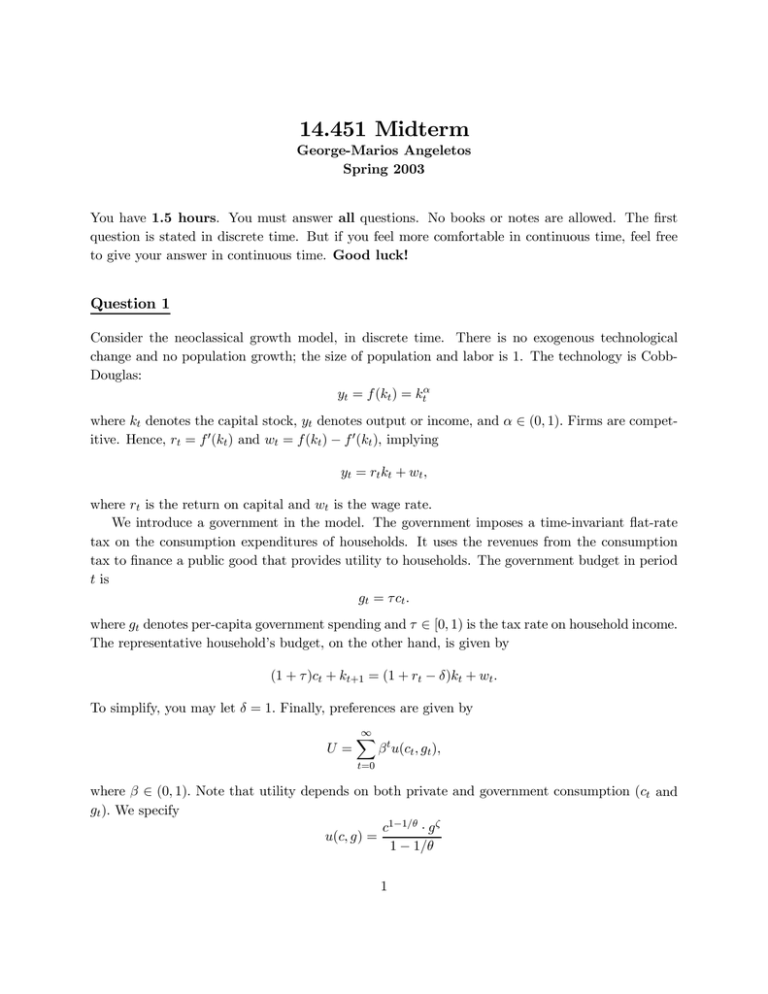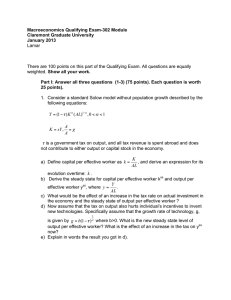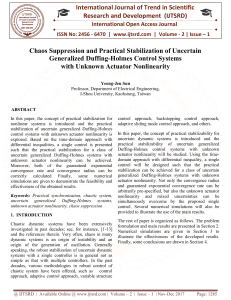Document 13567316
advertisement

14.451 Midterm George-Marios Angeletos Spring 2003 You have 1.5 hours. You must answer all questions. No books or notes are allowed. The first question is stated in discrete time. But if you feel more comfortable in continuous time, feel free to give your answer in continuous time. Good luck! Question 1 Consider the neoclassical growth model, in discrete time. There is no exogenous technological change and no population growth; the size of population and labor is 1. The technology is CobbDouglas: yt = f (kt ) = ktα where kt denotes the capital stock, yt denotes output or income, and α ∈ (0, 1). Firms are compet itive. Hence, rt = f 0 (kt ) and wt = f(kt ) − f 0 (kt ), implying yt = rt kt + wt , where rt is the return on capital and wt is the wage rate. We introduce a government in the model. The government imposes a time-invariant flat-rate tax on the consumption expenditures of households. It uses the revenues from the consumption tax to finance a public good that provides utility to households. The government budget in period t is gt = τ ct . where gt denotes per-capita government spending and τ ∈ [0, 1) is the tax rate on household income. The representative household’s budget, on the other hand, is given by (1 + τ )ct + kt+1 = (1 + rt − δ)kt + wt . To simplify, you may let δ = 1. Finally, preferences are given by U= ∞ X β t u(ct , gt ), t=0 where β ∈ (0, 1). Note that utility depends on both private and government consumption (ct and gt ). We specify c1−1/θ · g ζ u(c, g) = 1 − 1/θ 1 where θ > 0 and ζ < 1/θ. (a) What is the resource constraint of the economy? What is the Euler condition that char acterizes consumption growth in the competitive equilibrium? Write down the dynamic system that completely determines the evolution of c and k in the competitive allocation. (Hint: The two equations may involve only kt , ct , kt+1 , ct+1 and τ , but no other variable.) (b) How do the transitional dynamics depend on ζ? Is the rate of convergence to the steady state increasing, decreasing or independent of ζ? Interpret why. (Hint: You do not need to derive the convergence rate. Just give the intuition.) Also, consider the phase diagram. Does a higher ζ make the saddle path more concave or more convex? (c) Derive the steady-state values of c and k in terms of τ and the parameters (α, β, θ, ζ). How does k depend on ζ? How does k depend on τ ? Interpret these effects. (d) Suppose now that the technology is y = f (k) = Ak, so that there is endogenous growth. To simplify, let δ = 1. Suppose further that the government taxes total household income rather than consumption. The government budget is gt = τ yt and the household budget is ct + kt+1 = (1 − τ )rt kt , where rt = A. Derive the long-run growth rate of the economy? How does it depend on τ and ζ? Interpret. How does your answer here differ from your answer in part (c) above, and why? Question 2 (a) “The last half centuary has experienced a large increase in the cross-country dispersion of per-capita GDP levels, evidence that contradicts the hypothesis of conditional convergence.” Is this statement true, false, or uncertain? Provide a brief explanation. (b) Consider the neoclassical growth model with exogenously fixed labor. Briefly describe the response of aggregate consumption, investment, and output to a permanent increase in the level of TFP. (c) “If the aggregate technology exhibits constant returns with respect to the vector of accumu lable factors (different types of capital), then the economy has necessarily a constant growth rate at all times and it is impossible to make sense of conditional convergence.” Is this statement true, false, or uncertain? Provide a brief explanation. (d) “More product-market competition necessarily promotes economic growth and social wel fare, as firms are forced to produce more goods and extract less profits from consumers.” Is this statement true, false, or uncertain? Provide a brief explanation. Good Luck! 2







